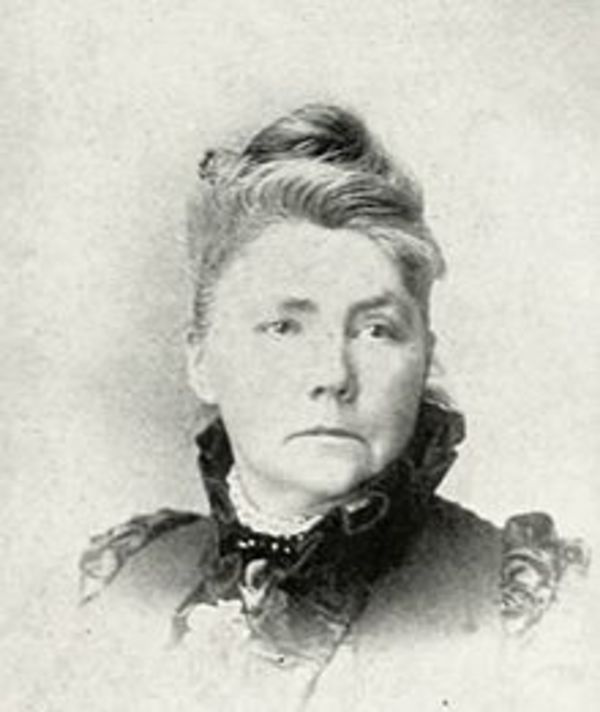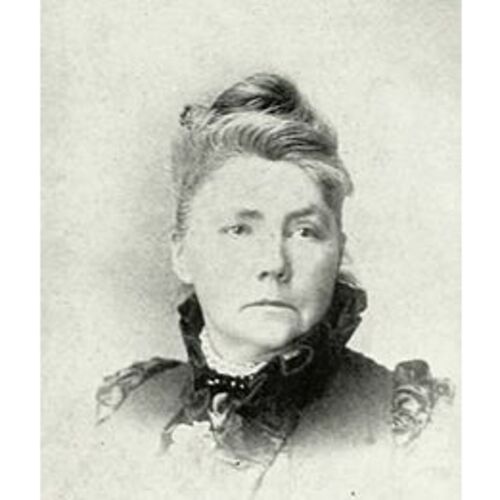
Source: Courtesy of Wikimedia Commons
MOUNTCASTLE, CLARA H., also known as Caris Sima, painter, teacher, and author; b. 26 Nov. 1837 in the Huron Tract, near the site of Clinton, Upper Canada, daughter of Sidney Harman Mountcastle and Frances Laura Meikle; d. unmarried 24 May 1908 in Clinton.
The third surviving daughter of 12 children, Clara H. Mountcastle (her full name remains unknown) was born into an artistic family that had left London, England, in 1832 to better its fortunes in Upper Canada. Like other well-born immigrants the Mountcastles struggled to make a living in the bush, with Sidney either farming or engaged in a variety of commercial ventures. The family’s occupational and financial instability was matched by physical precariousness: only five children survived to adulthood. Despite the difficulty of her early years Clara eulogized the log house where she was born in her poem “A picture of the past”; “My Eden, my childhood’s abode. / The low spreading homestead, with roses o’ergrown.” The darker side of bush life is presented in “Lost!” which, with only slightly changed names, relates an autobiographical tale of children lost in the backwoods while bringing in the cows.
Educated first at home by her mother, an amateur painter, Clara developed her artistic talent with lessons from her uncle John George Howard*, an architect in whose Toronto house she resided from 1855 to 1857. While there, she attended a private girls’ school for a term and took instruction from an English artist, one Chatterton, in working from nature. At an unknown date she taught English at a girls’ school in St Catharines, and in June 1868 she rejoined Howard’s household and took further sketching and colouring lessons. By 1881 she had returned to Clinton.
In addition to displaying her work at home and teaching art at the public library she participated in a number of exhibitions. Her water-colours won two first prizes and three seconds in the amateur class of the 1870 Provincial Exhibition, held in Toronto. She exhibited another water-colour in 1888 at the combined exhibition in Toronto of the Ontario Society of Artists [see John Arthur Fraser*] and the Royal Canadian Academy of Arts [see John Douglas Sutherland Campbell*; Lucius Richard O’Brien*] and an oil painting at the Toronto Industrial Exhibition three years later. Although George Maclean Rose*, a Toronto publisher and biographer, wrote in 1888 that “she has not yet attained that high finish which only study under the best masters can give,” in 1898 author Henry James Morgan* praised her skill in marine views, noting that “she is regarded as being very successful in the effect produced by moving water.” Her attempt to be included in the 1897 OSA exhibition was frustrated when, despite an invitation from its secretary to submit her work, her two landscape paintings were rejected by the jury, which wanted to encourage art resembling French Impressionism. She dramatized the clash in her poem “The artist’s soliloquy”:
They looked upon my work and found
No misty stretch of foreign ground,
But trees and bushes hung around
With richness of our scenery.
And said ‘We have no need of these,
These Autumn-tinted glowing trees
And vast tumultuous inland seas.
The French have no such imag’ry.’
When her bid to join that organization was blocked by “the men who said me nay; / The rulers of the O.S.A.,” she joined the Women’s Art Association of Canada.
Although Clara painted and exhibited for many years she earned her contemporary reputation as a writer, a career late in starting because of what she described as a “prolonged illness.” Rose published her first two books, The mission of love (1882), a collection of poems, and A mystery (1886), a novel, both written under the pseudonym Caris Sima (from carissima, Italian for “most beloved,” a term conferred upon her in childhood by a family friend). Her third book, Is marriage a failure? (1899), appeared under her own name. In addition, some dozen of her poems were published in Edmund Ernest Sheppard*’s Saturday Night (Toronto) from 1889 to 1898.
Her high-spiritedness is much in evidence in a lively attack on the social privilege granted married people in her essay “Is marriage a failure?” (to which she gives a qualified answer) and in epigrammatic gibes on the same topic in A mystery. In poetry too she rose to polemic. After Joseph Edmund Collins* criticized The mission of love as being “a garden in which there are several unseemly weeds growing side by side with a number of delightful flowers,” she replied in her poem “To a critic” by warning him not to touch “my roses, my sweet mignonette” when he weeded in her garden, a garden that “ran wild while I struggled for bread.”
In that book, typical newspaper fare, such as a poem about rower Edward Hanlan, appears alongside “The voice of the waters,” a tale of ill-fated love by Lake Huron in which Collins saw “a wild wealth of imagination, a flowing music, a profusion of epithet, and a boundless command of rhyme.” Her versatility – she tried dialect verse, valentine, hymn, patriotic song, political protest, meditation on mutability, myth, dream landscape – earned her the praise of such contemporaries as Rose, who said that “no poet living or dead ever wrote in such varied style.” Noticeable in equal measure are echoes of Wordsworth, Poe, and the Pre-Raphaelites. While “wit and dry humor” characterize her prose, the constant in Clara’s poetry is the elegiac tone of late-19th-century Romanticism. Both genres are marred by clumsy handling of formal structures and awkward framing strategies; in addition, her poems suffered from overworked rhyming couplets and her fiction from the absence of suspense. None the less, she enjoyed an international reputation. American women, a reference work of collective biography, reported in its 1897 edition that she had been made an honorary member of the Trinity Historical Society of Dallas, Tex., and that she was a “forceful and dramatic reader.”
Readers today are not as likely as Clara’s contemporaries were to appreciate her poetry for being, in the words of her obituary, “true to nature and easily understood.” However, these are important elements in verse destined to be recited, as much of her work was in readings she gave at home and elsewhere to help earn her living. Like the Lindwood sisters in A mystery, Clara and her sisters Ellen and Eliza, who also drew and wrote, lived together in genteel poverty “add[ing] to their small income by various fancy works, learned as a pastime in the days of their prosperity.” She may also have helped Eliza with the school she ran in their home. Although modern readers are likely to be interested in Clara’s writing and life only for historical and not literary reasons, they may linger over a poem such as “My sisters and I” for the pathos and homely imagery in its portrait of poverty-stricken old women:
The years roll on. Youth flies apace;
And age o’ertakes us in the race;
While poverty runs neck and neck.
And little doth the oppressor reck
That oft he sets his iron heel
Upon the corn we sorest feel.
In this depiction of the trials of ageing she reaffirms her commitment to poetry that is “strong, simple and touching.” Clara Mountcastle shared with such contemporaries as Archibald Lampman*, William Bliss Carman*, Charles George Douglas Roberts*, and Duncan Campbell Scott* a belief in the “civilizing” role of literature and its importance in nation building. Her work is a feminine footnote in that turn-of-the-century effort to develop a national literature.
Clara H. Mountcastle’s publications include The mission of love; Lost; and other poems, with songs and valentines (Toronto, 1882), A mystery (Toronto, 1886), and Is marriage a failure? Lost! and many gems of verse (Toronto, 1899). The account of her life in American women . . . , ed. F. E. Willard and M. A. [Rice] Livermore (rev. ed., 2v., New York, 1897; repr. Detroit, 1973) is accompanied by a photograph; the obituary of Ellen Mountcastle in the Clinton News-Record (Clinton, Ont.), 23 Feb. 1922, includes a photograph of the three sisters in old age. A photograph of the sisters also appears in the Toronto Daily Star’s Star Weekly magazine for 25 Feb. 1922.
AO, F 1401; RG 22, ser.298, no.5623. MTRL, J. G. Howard papers. NA, RG 31, C1, 1881, Clinton. Clinton New Era, 25 Jan. 1877, 16 Oct. 1891, 28 May 1908. Clinton News-Record, 16, 25 Feb. 1922. Globe, 7 Oct. 1870. Canadian men and women of the time (Morgan; 1898). Colborne Lodge, High Park, Toronto; first occupied December 23, 1837, comp. F. C. Parker ([Toronto, 1949]). J. E. Collins, Life and times of the Right Honourable Sir John A. Macdonald . . . premier of the Dominion of Canada (Toronto, 1883), 492–94. Cyclopædia of Canadian biog. (Rose and Charlesworth), vols.1–2. Harper, Early painters and engravers. History of Clinton and surrounding community, 1950 (Clinton, 1950). An index to “Saturday Night”; the first fifty years, 1887–1937, ed. G. F. Heggie and G. R. Adshead (Toronto, 1987). Kathleen Lockhart, “The Mountcastle family,” History of Clinton, 1875–1975 ([Clinton, 1975]), 70–71. RCAA exhibitions (McMann).
Cite This Article
Barbara Godard, “MOUNTCASTLE, CLARA H. (Caris Sima),” in Dictionary of Canadian Biography, vol. 13, University of Toronto/Université Laval, 2003–, accessed December 30, 2025, https://www.biographi.ca/en/bio/mountcastle_clara_h_13E.html.
The citation above shows the format for footnotes and endnotes according to the Chicago manual of style (16th edition). Information to be used in other citation formats:
| Permalink: | https://www.biographi.ca/en/bio/mountcastle_clara_h_13E.html |
| Author of Article: | Barbara Godard |
| Title of Article: | MOUNTCASTLE, CLARA H. (Caris Sima) |
| Publication Name: | Dictionary of Canadian Biography, vol. 13 |
| Publisher: | University of Toronto/Université Laval |
| Year of publication: | 1994 |
| Year of revision: | 1994 |
| Access Date: | December 30, 2025 |



